Impact Assessment of Soil and Water Conservation Measures on Carbon Sequestration: A Case Study for the Tropical Watershed Using Advanced Geospatial Techniques
Abstract
:1. Introduction
2. Material and Method
2.1. Description of Study Area
2.2. Soil and Water Conservation Measures in the Watershed
2.3. Change Detection Analysis of Watershed
2.4. Estimation of Soil Loss from Watershed
2.5. Description of USLE Parameters
2.5.1. Rainfall Erosivity Factor (R)
2.5.2. Soil Erodibility Factor (K)
2.5.3. Slope Length Factor (LS)
2.5.4. Crop Management Factor (C)
2.5.5. Conservation Practice Factor (P)
2.6. Estimation of Carbon Loss from Watershed
2.7. Estimation of Impact of SWC Measures on Carbon Sequestration
2.7.1. Soil Sampling
2.7.2. Soil Analysis
2.7.3. Soil Organic Carbon Stock and SOC Sequestration Rate
3. Statistical Analysis
4. Result and Discussion
4.1. Impact of SWC Measures on Land Cover
4.2. Impact of SWC Measures on Soil Erosion
4.2.1. Soil Loss from Watershed before Conservation Measures
R Factor
K Factor
LS Factor
C Factor
P Factor
4.3. Soil Loss before Conservation Measures
4.4. Soil Loss from the Watershed after Conservation Measures
4.5. Carbon Loss from the Watershed
4.5.1. Before Conservation Measures Carbon Loss
4.5.2. After Conservation Measures Carbon Loss
4.6. Impact of SWC Measures on Carbon Sequestration
4.6.1. SOC Content
4.6.2. Bulk Density
4.6.3. SOC Stock and Soil Carbon Sequestration Rate
5. Conclusions
Author Contributions
Funding
Institutional Review Board Statement
Informed Consent Statement
Data Availability Statement
Acknowledgments
Conflicts of Interest
References
- Hoque, M.A.-A.; Pradhan, B.; Ahmed, N. Assessing Drought Vulnerability Using Geospatial Techniques in Northwestern Part of Bangladesh. Sci. Total Environ. 2020, 705, 135957. [Google Scholar] [CrossRef] [PubMed]
- Ahmad, M.M.; Yaseen, M.; Saqib, S.E. Climate Change Impacts of Drought on the Livelihood of Dryland Smallholders: Implications of Adaptation Challenges. Int. J. Disaster Risk Reduct. 2022, 80, 103210. [Google Scholar] [CrossRef]
- Thammanu, S.; Marod, D.; Han, H.; Bhusal, N.; Asanok, L.; Ketdee, P.; Gaewsingha, N.; Lee, S.; Chung, J. The Influence of Environmental Factors on Species Composition and Distribution in a Community Forest in Northern Thailand. J. For. Res. 2020, 32, 649–662. [Google Scholar] [CrossRef]
- Islam, A. Climate Change and Its Impact on Sustainable Development in Bangladesh. Int. J. Econ. Energy Environ. 2017, 2, 90. [Google Scholar] [CrossRef] [Green Version]
- Nyssen, J.; Frankl, A.; Zenebe, A.; Deckers, J.; Poesen, J. Land Management in the Northern Ethiopian Highlands: Local and Global Perspectives; Past, Present and Future. Land Degrad. Dev. 2015, 26, 759–764. [Google Scholar] [CrossRef]
- Mandal, D.; Giri, N.; Srivastava, P. The Magnitude of Erosion-Induced Carbon © Flux and C-Sequestration Potential of Eroded Lands in India. Eur. J. Soil Sci. 2020, 71, 151–168. [Google Scholar] [CrossRef]
- Degu, M.; Melese, A.; Tena, W. Effects of Soil Conservation Practice and Crop Rotation on Selected Soil Physicochemical Properties: The Case of Dembecha District, Northwestern Ethiopia. Appl. Environ. Soil Sci. 2019, 2019, 6910879. [Google Scholar] [CrossRef] [Green Version]
- Fang, H. The Effect of Soil Conservation Measures on Runoff, Soil Erosion, TN, and TP Losses Based on Experimental Runoff Plots in Northern China. Water 2021, 13, 2334. [Google Scholar] [CrossRef]
- Mekonnen, M.; Getahun, M. Soil Conservation Practices Contribution in Trapping Sediment and Soil Organic Carbon, Minizr Watershed, Northwest Highlands of Ethiopia. J. Soils Sediments 2020, 20, 2484–2494. [Google Scholar] [CrossRef]
- Addis, H.K.; Abera, A.; Abebaw, L. Economic Benefits of Soil and Water Conservation Measures at the Sub-Catchment Scale in the Northern Highlands of Ethiopia. Prog. Phys. Geogr. Earth Environ. 2019, 44, 251–266. [Google Scholar] [CrossRef]
- Tanto, T.; Laekemariam, F. Impacts of Soil and Water Conservation Practices on Soil Property and Wheat Productivity in Southern Ethiopia. Environ. Syst. Res. 2019, 8, 1–9. [Google Scholar] [CrossRef]
- Simon, A.; Dhendup, K.; Rai, P.B.; Gratzer, G. Soil Carbon Stocks along Elevational Gradients in Eastern Himalayan Mountain Forests. Geoderma Reg. 2018, 12, 28–38. [Google Scholar] [CrossRef]
- Wiesmeier, M.; Urbanski, L.; Hobley, E.; Lang, B.; von Lützow, M.; Marin-Spiotta, E.; van Wesemael, B.; Rabot, E.; Ließ, M.; Garcia-Franco, N.; et al. Soil Organic Carbon Storage as a Key Function of Soils—A Review of Drivers and Indicators at Various Scales. Geoderma 2019, 333, 149–162. [Google Scholar] [CrossRef]
- Liao, C.; Tian, Q.; Liu, F. Nitrogen Availability Regulates Deep Soil Priming Effect by Changing Microbial Metabolic Efficiency in a Subtropical Forest. J. For. Res. 2020, 32, 713–723. [Google Scholar] [CrossRef]
- Wang, Z. Estimating Terrestrial Carbon Storage and Internal Carbon Exchange under Equilibrium State. Ecol. Model. 2019, 401, 94–110. [Google Scholar] [CrossRef]
- Deng, L.; Wang, K.; Zhu, G.; Liu, Y.; Chen, L.; Shangguan, Z. Changes of Soil Carbon in Five Land Use Stages Following 10 years of Vegetation Succession on the Loess Plateau, China. Catena 2018, 171, 185–192. [Google Scholar] [CrossRef]
- Tang, X.; Zhao, X.; Bai, Y.; Tang, Z.; Wang, W.; Zhao, Y.; Wan, H.; Xie, Z.; Shi, X.; Wu, B.; et al. Carbon Pools in China’s Terrestrial Ecosystems: New Estimates Based on an Intensive Field Survey. Proc. Natl. Acad. Sci. USA 2018, 115, 4021–4026. [Google Scholar] [CrossRef] [Green Version]
- Hounkpatin, O.K.L.; Op de Hipt, F.; Bossa, A.Y.; Welp, G.; Amelung, W. Soil Organic Carbon Stocks and Their Determining Factors in the Dano Catchment (Southwest Burkina Faso). Catena 2018, 166, 298–309. [Google Scholar] [CrossRef]
- Cardinael, R.; Chevallier, T.; Cambou, A.; Béral, C.; Barthès, B.G.; Dupraz, C.; Durand, C.; Kouakoua, E.; Chenu, C. Increased Soil Organic Carbon Stocks under Agroforestry: A Survey of Six Different Sites in France. Agric. Ecosyst. Environ. 2017, 236, 243–255. [Google Scholar] [CrossRef] [Green Version]
- Mahajan, G.R.; Das, B.; Manivannan, S.; Manjunath, B.L.; Verma, R.R.; Desai, S.; Kulkarni, R.M.; Latare, A.M.; Sale, R.; Murgaonkar, D.; et al. Soil and Water Conservation Measures Improve Soil Carbon Sequestration and Soil Quality under Cashews. Int. J. Sediment Res. 2021, 36, 190–206. [Google Scholar] [CrossRef]
- Adhikary, P.P.; Hombegowda, H.C.; Barman, D.; Jakhar, P.; Madhu, M. Soil Erosion Control and Carbon Sequestration in Shifting Cultivated Degraded Highlands of Eastern India: Performance of Two Contour Hedgerow Systems. Agrofor. Syst. 2016, 91, 757–771. [Google Scholar] [CrossRef]
- Hailu, L.; Betemariyam, M. Comparison of Soil Organic Carbon and Total Nitrogen Stocks between Farmland Treated with Three and Six Years Level Soil Bund and Adjacent Farmland without Conservation Measure: In the Case of Southwestern Ethiopia. PLoS ONE 2021, 16, e0252123. [Google Scholar] [CrossRef]
- Fang, J.; Yu, G.; Liu, L.; Hu, S.; Chapin, F.S. Climate Change, Human Impacts, and Carbon Sequestration in China. Proc. Natl. Acad. Sci. USA 2018, 115, 4015–4020. [Google Scholar] [CrossRef] [PubMed] [Green Version]
- Sriyana, I.; De Gijt, J.G.; Parahyangsari, S.K.; Niyomukiza, J.B. Watershed Management Index Based on the Village Watershed Model (VWM) Approach towards Sustainability. Int. Soil Water Conserv. Res. 2020, 8, 35–46. [Google Scholar] [CrossRef]
- Page, K.L.; Dang, Y.P.; Dalal, R.C. The Ability of Conservation Agriculture to Conserve Soil Organic Carbon and the Subsequent Impact on Soil Physical, Chemical, and Biological Properties and Yield. Front. Sustain. Food Syst. 2020, 4, 31. [Google Scholar] [CrossRef] [Green Version]
- Ranjan, R.; Kumar, D.; Yadav, R.S.; Pramanik, M.; Meena, M.K.; Sinha, N.K. Conservation Agriculture for Carbon Sequestration and Mitigation of Climate Change. In Conservation Agriculture: A Sustainable Approach for Soil Health and Food Security; Springer: Singapore, 2021; pp. 433–449. [Google Scholar] [CrossRef]
- Demenois, J.; Torquebiau, E.; Arnoult, M.H.; Eglin, T.; Masse, D.; Assouma, M.H.; Blanfort, V.; Chenu, C.; Chapuis-Lardy, L.; Medoc, J.-M.; et al. Barriers and Strategies to Boost Soil Carbon Sequestration in Agriculture. Front. Sustain. Food Syst. 2020, 4, 37. [Google Scholar] [CrossRef] [Green Version]
- Kumawat, A.; Yadav, D.; Samadharmam, K.; Rashmi, I. Soil and Water Conservation Measures for Agricultural Sustainability. Soil Moisture Importance 2020, 23. [Google Scholar] [CrossRef]
- Pei, T.; Xu, J.; Liu, Y.; Huang, X.; Zhang, L.; Dong, W.; Qin, C.; Song, C.; Gong, J.; Zhou, C. GIScience and Remote Sensing in Natural Resource and Environmental Research: Status Quo and Future Perspectives. Geogr. Sustain. 2021, 2, 207–215. [Google Scholar] [CrossRef]
- Zhao, Q.; Yu, L.; Du, Z.; Peng, D.; Hao, P.; Zhang, Y.; Gong, P. An Overview of the Applications of Earth Observation Satellite Data: Impacts and Future Trends. Remote Sens. 2022, 14, 1863. [Google Scholar] [CrossRef]
- Nikoobakht, S.; Azarafza, M.; Akgün, H.; Derakhshani, R. Landslide Susceptibility Assessment by Using Convolutional Neural Network. Appl. Sci. 2022, 12, 5992. [Google Scholar] [CrossRef]
- Azarafza, M.; Azarafza, M.; Akgün, H.; Atkinson, P.M.; Derakhshani, R. Deep Learning-Based Landslide Susceptibility Mapping. Sci. Rep. 2021, 11, 1–16. [Google Scholar] [CrossRef] [PubMed]
- Kotkar, S.R.; Jadhav, B.D. Analysis of Various Change Detection Techniques Using Satellite Images. In Proceedings of the 2015 International Conference on Information Processing (ICIP), Pune, India, 16–19 December 2015. [Google Scholar] [CrossRef]
- Pimentel, D. Soil Erosion: A Food and Environmental Threat. Environ. Dev. Sustain. 2006, 8, 119–137. [Google Scholar] [CrossRef]
- Wischmeier, W.H. Predicting Rainfall Erosion Losses. A Guide to Conservation Planning. In The USDA Agricultural Handbook No. 537; Department of Agriculture, Science and Education Administration: Washington, DC, USA, 1978. [Google Scholar]
- Wu, Q.; Jiang, X.; Lu, Q.; Li, J.; Chen, J. Changes in Soil Organic Carbon and Aggregate Stability Following a Chronosequence of Liriodendron Chinense Plantations. J. For. Res. 2020, 32, 355–362. [Google Scholar] [CrossRef]
- Han, W.; Wang, J.; Kang, J.; Li, L.; Peng, G. Erosion Characteristics of Hydraulic Turbine Guide-Vane End Clearance in Sediment Water Flow: A Simplified Model Analysis. J. Flow Control Meas. Vis. 2017, 05, 111–126. [Google Scholar] [CrossRef] [Green Version]
- Adewumi, J.K.; Musa, J.J.; Adeosun, O.J.; Akpoebidimiyen, O.E.; Adekunle, A.; Adewumi, B.S. Soil Detachment with Organic Mulching Using Rainfall Simulator in Comparison with a Short Duration Natural Rainfall for Effective Soil Conservation. J. Environ. Prot. 2020, 11, 457–469. [Google Scholar] [CrossRef]
- Ebrahimi, M.; Nejadsoleymani, H.; Sadeghi, A.; Mansouri Daneshvar, M.R. Assessment of the Soil Loss-Prone Zones Using the USLE Model in Northeastern Iran. Paddy Water Environ. 2020, 19, 71–86. [Google Scholar] [CrossRef]
- Kashiwar, S.R.; Kundu, M.C.; Dongarwar, U.R. Soil Erosion Estimation of Bhandara Region of Maharashtra, India, by Integrated Use of RUSLE, Remote Sensing, and GIS. Nat. Hazards 2021, 110, 937–959. [Google Scholar] [CrossRef]
- Chadli, K. Estimation of Soil Loss Using RUSLE Model for Sebou Watershed (Morocco). Model. Earth Syst. Environ. 2016, 2, 1–10. [Google Scholar] [CrossRef]
- El Jazouli, A.; Barakat, A.; Ghafiri, A.; El Moutaki, S.; Ettaqy, A.; Khellouk, R. Soil Erosion Modeled with USLE, GIS, and Remote Sensing: A Case Study of Ikkour Watershed in Middle Atlas (Morocco). Geosci. Lett. 2017, 4, 1–12. [Google Scholar] [CrossRef] [Green Version]
- Girmay, G.; Moges, A.; Muluneh, A. Estimation of Soil Loss Rate Using the USLE Model for Agewmariayam Watershed, Northern Ethiopia. Agric. Food Secur. 2020, 9, 1–12. [Google Scholar] [CrossRef]
- Chandramohan, T.; Durbude, D.G. Estimation of Soil Erosion Potential Using Universal Soil Loss Equation. J. Indian Soc. Remote Sens. 2002, 30, 181–190. [Google Scholar] [CrossRef]
- Pancholi, V.; Lodha, P.; Prakash, I. Estimation of Runoff and Soil Erosion for Vishwamitri River Watershed, Western India Using RS and GIS. Am. J. Water Sci. Eng. 2015, 1, 7–14. [Google Scholar] [CrossRef]
- Braun, K.N.; Theuerkauf, E.J.; Hurtgen, M.T.; Masterson, A.L.; Horton, D.E. Loss-On-Ignition Estimates for Soil Organic Carbon in Great Lakes Freshwater Coastal Wetlands. Wetlands 2020, 40, 1201–1206. [Google Scholar] [CrossRef]
- Dayathilake, D.D.T.L.; Lokupitiya, E.; Wijeratne, V.P.I.S. Estimation of Soil Carbon Stocks of Urban Freshwater Wetlands in the Colombo Ramsar Wetland City and Their Potential Role in Climate Change Mitigation. Wetlands 2021, 41, 1–10. [Google Scholar] [CrossRef]
- Ferretto, A.; Brooker, R.; Aitkenhead, M.; Matthews, R.; Smith, P. Potential Carbon Loss from Scottish Peatlands under Climate Change. Reg. Environ. Chang. 2019, 19, 2101–2111. [Google Scholar] [CrossRef] [Green Version]
- Bache, B.W.; Chesworth, W.; Chesworth, W.; Gessa, C.; Lewis, D.T. Bulk Density. In Encyclopedia of Soil Science; Springer: Berlin/Heidelberg, Germany, 2008; pp. 74–75. [Google Scholar] [CrossRef]
- Byers, S.C.; Mills, E.L.; Stewart, P.L. A Comparison of Methods of Determining Organic Carbon in Marine Sediments, with Suggestions for a Standard Method. Hydrobiologia 1978, 58, 43–47. [Google Scholar] [CrossRef]
- Bieganowski, A.; Ryżak, M. Soil Texture: Measurement Methods. In Encyclopedia of Agrophysics; Springer: Berlin/Heidelberg, Germany, 2011; pp. 791–794. [Google Scholar] [CrossRef]
- Lorenz, K.; Lal, R. Soil Carbon Stock. In Carbon Sequestration in Agricultural Ecosystems; Springer: Berlin/Heidelberg, Germany, 2018; pp. 39–136. [Google Scholar] [CrossRef]
- Blake, G.R.; Steinhardt, G.C.; Pombal, X.P.; Muñoz, J.C.N.; Cortizas, A.M.; Arnold, R.W.; Schaetzl, R.J.; Stagnitti, F.; Parlange, J.-Y.; Steenhuis, T.S.; et al. Permeability. In Encyclopedia of Soil Science; Springer: Berlin/Heidelberg, Germany, 2008; pp. 531–538. [Google Scholar] [CrossRef]
- Hudson, N. Soil Conservation; Batsford: London, UK, 1995; ISBN 9780713473537. [Google Scholar]
- Bhattacharyya, R.; Ghosh, B.; Mishra, P.; Mandal, B.; Rao, C.; Sarkar, D.; Das, K.; Anil, K.; Lalitha, M.; Hati, K.; et al. Soil Degradation in India: Challenges and Potential Solutions. Sustainability 2015, 7, 3528–3570. [Google Scholar] [CrossRef] [Green Version]
- Nasir Ahmad, N.S.B.; Mustafa, F.B.; Muhammad Yusoff, S.Y.; Didams, G. A Systematic Review of Soil Erosion Control Practices on the Agricultural Land in Asia. Int. Soil Water Conserv. Res. 2020, 8, 103–115. [Google Scholar] [CrossRef]
- Lense, G.H.E.; Moreira, R.S.; Parreiras, T.C.; Avanzi, J.C.; Mincato, R.L. Modelagem Da Perda de Carbono Orgânico Do Solo Por Erosão Hídrica Em Uma Bacia Hidrográfica Tropical. Rev. Ciência Agronômica 2021, 52. [Google Scholar] [CrossRef]
- Furtak, K.; Gajda, A.M. Activity and Variety of Soil Microorganisms Depending on the Diversity of the Soil Tillage System. Sustain. Agroecosystems 2018, 45. [Google Scholar] [CrossRef] [Green Version]
- Hellwig, N.; Gómez-Brandón, M.; Ascher-Jenull, J.; Bardelli, T.; Anschlag, K.; Fornasier, F.; Pietramellara, G.; Insam, H.; Broll, G. Humus Forms and Soil Microbiological Parameters in a Mountain Forest: Upscaling to the Slope Scale. Soil Syst. 2018, 2, 12. [Google Scholar] [CrossRef] [Green Version]
- Belay, A.; Eyasu, E. Effect of Soil and Water Conservation (SWC) Measures on Soil Nutrient and Moisture Status, a Case of Two Selected Watersheds. J. Agric. Ext. Rural Dev. 2019, 11, 85–93. [Google Scholar] [CrossRef]
- Nave, L.E.; Swanston, C.W.; Mishra, U.; Nadelhoffer, K.J. Afforestation Effects on Soil Carbon Storage in the United States: A Synthesis. Soil Sci. Soc. Am. J. 2013, 77, 1035–1047. [Google Scholar] [CrossRef] [Green Version]
- Bárcena, T.G.; Kiær, L.P.; Vesterdal, L.; Stefánsdóttir, H.M.; Gundersen, P.; Sigurdsson, B.D. Soil Carbon Stock Change Following Afforestation in Northern Europe: A Meta-Analysis. Glob. Chang. Biol. 2014, 20, 2393–2405. [Google Scholar] [CrossRef] [PubMed]
- Miheretu, B.A.; Yimer, A.A. Spatial Variability of Selected Soil Properties in Relation to Land Use and Slope Position in Gelana Sub-Watershed, Northern Highlands of Ethiopia. Phys. Geogr. 2017, 39, 230–245. [Google Scholar] [CrossRef]
- Wubie, M.A.; Assen, M. Effects of Land Cover Changes and Slope Gradient on Soil Quality in the Gumara Watershed, Lake Tana Basin of North–West Ethiopia. Model. Earth Syst. Environ. 2019, 6, 85–97. [Google Scholar] [CrossRef] [Green Version]
- Calvo de Anta, R.; Luís, E.; Febrero-Bande, M.; Galiñanes, J.; Macías, F.; Ortíz, R.; Casás, F. Soil Organic Carbon in Peninsular Spain: Influence of Environmental Factors and Spatial Distribution. Geoderma 2020, 370, 114365. [Google Scholar] [CrossRef]
- Ekholm, P.; Lehtoranta, J. Does Control of Soil Erosion Inhibit Aquatic Eutrophication? J. Environ. Manag. 2012, 93, 140–146. [Google Scholar] [CrossRef]
- Mesfin, S.; Taye, G.; Hailemariam, M. Effects of Integrated Soil and Water Conservation Measures on Soil Aggregate Stability, Soil Organic Matter and Soil Organic Carbon Stock of Smallholder Farmlands in Semi-Arid Northern Ethiopia. Carbon Manag. 2018, 9, 155–164. [Google Scholar] [CrossRef]
- Walter, C.; Merot, P.; Layer, B.; Dutin, G. The Effect of Hedgerows on Soil Organic Carbon Storage in Hillslopes. Soil Use Manag. 2003, 19, 201–207. [Google Scholar] [CrossRef]
- Wang, C.; Pan, G.; Tian, Y.; Li, L.; Zhang, X.; Han, X. Changes in Cropland Topsoil Organic Carbon with Different Fertilizations under Long-Term Agro-Ecosystem Experiments across Mainland China. Sci. China Life Sci. 2010, 53, 858–867. [Google Scholar] [CrossRef] [PubMed]
- Buysse, P.; Roisin, C.; Aubinet, M. Fifty Years of Contrasted Residue Management of an Agricultural Crop: Impacts on the Soil Carbon Budget and on Soil Heterotrophic Respiration. Agric. Ecosyst. Environ. 2013, 167, 52–59. [Google Scholar] [CrossRef]
- Johnson, J.; Reicosky, D.; Allmaras, R.; Sauer, T.; Venterea, R.; Dell, C. Greenhouse Gas Contributions and Mitigation Potential of Agriculture in the Central USA. Soil Tillage Res. 2005, 83, 73–94. [Google Scholar] [CrossRef]
- Raji, B.A.; Ogunwole, J.O. Potential of Soil Carbon Sequestration under Various Landuse in the Sub-Humid and Semi-Arid Savanna of Nigeria: Lessons from Long-Term Experiments. Int. J. Soil Sci. 2005, 1, 33–43. [Google Scholar] [CrossRef]
- Poulton, P.R.; Pye, E.; Hargreaves, P.R.; Jenkinson, D.S. Accumulation of Carbon and Nitrogen by Old Arable Land Reverting to Woodland. Glob. Chang. Biol. 2003, 9, 942–955. [Google Scholar] [CrossRef]
- Martin-Roberts, E.; Scott, V.; Flude, S.; Johnson, G.; Haszeldine, R.S.; Gilfillan, S. Carbon Capture and Storage at the End of a Lost Decade. One Earth 2021, 4, 1569–1584. [Google Scholar] [CrossRef]
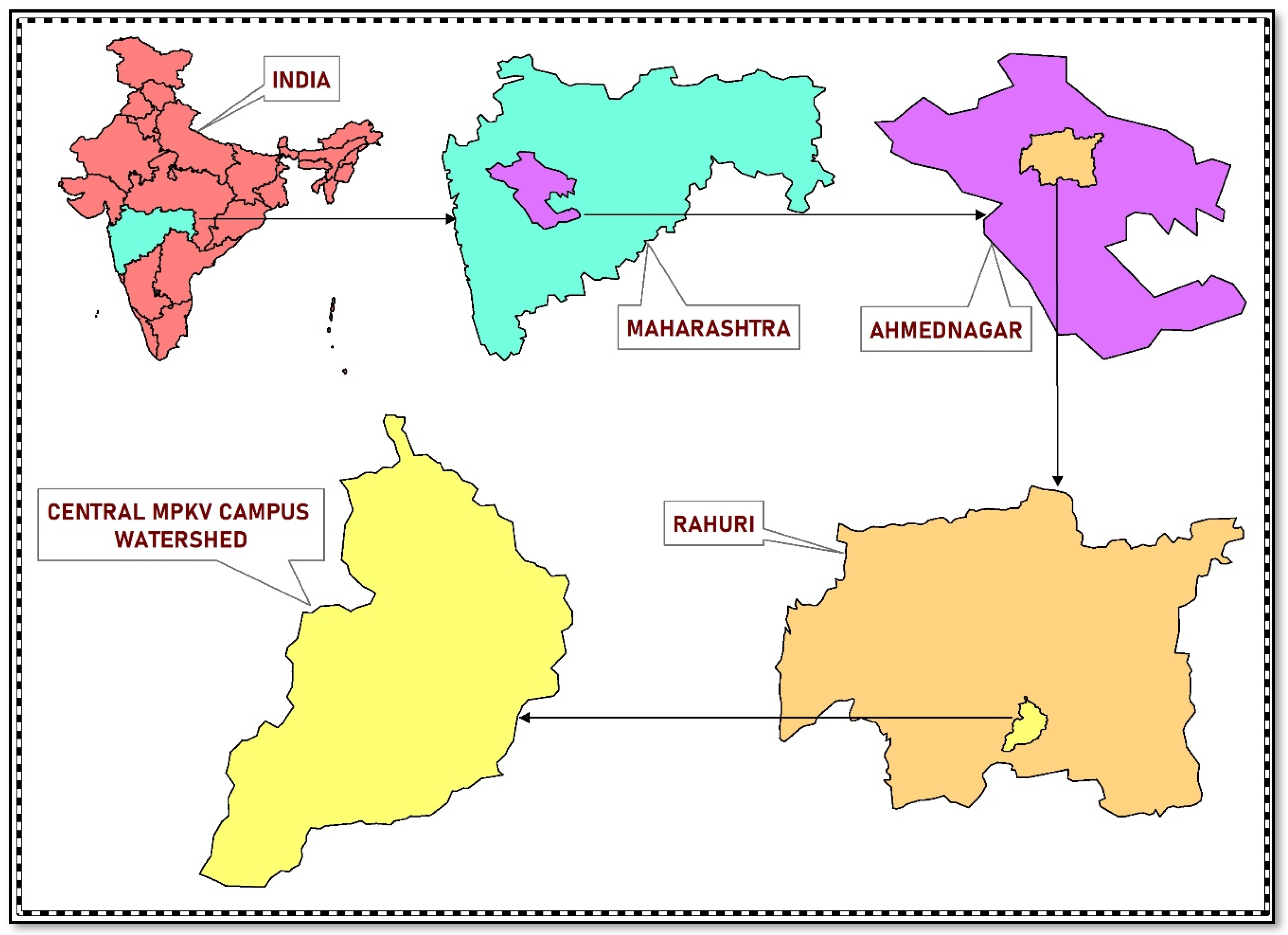
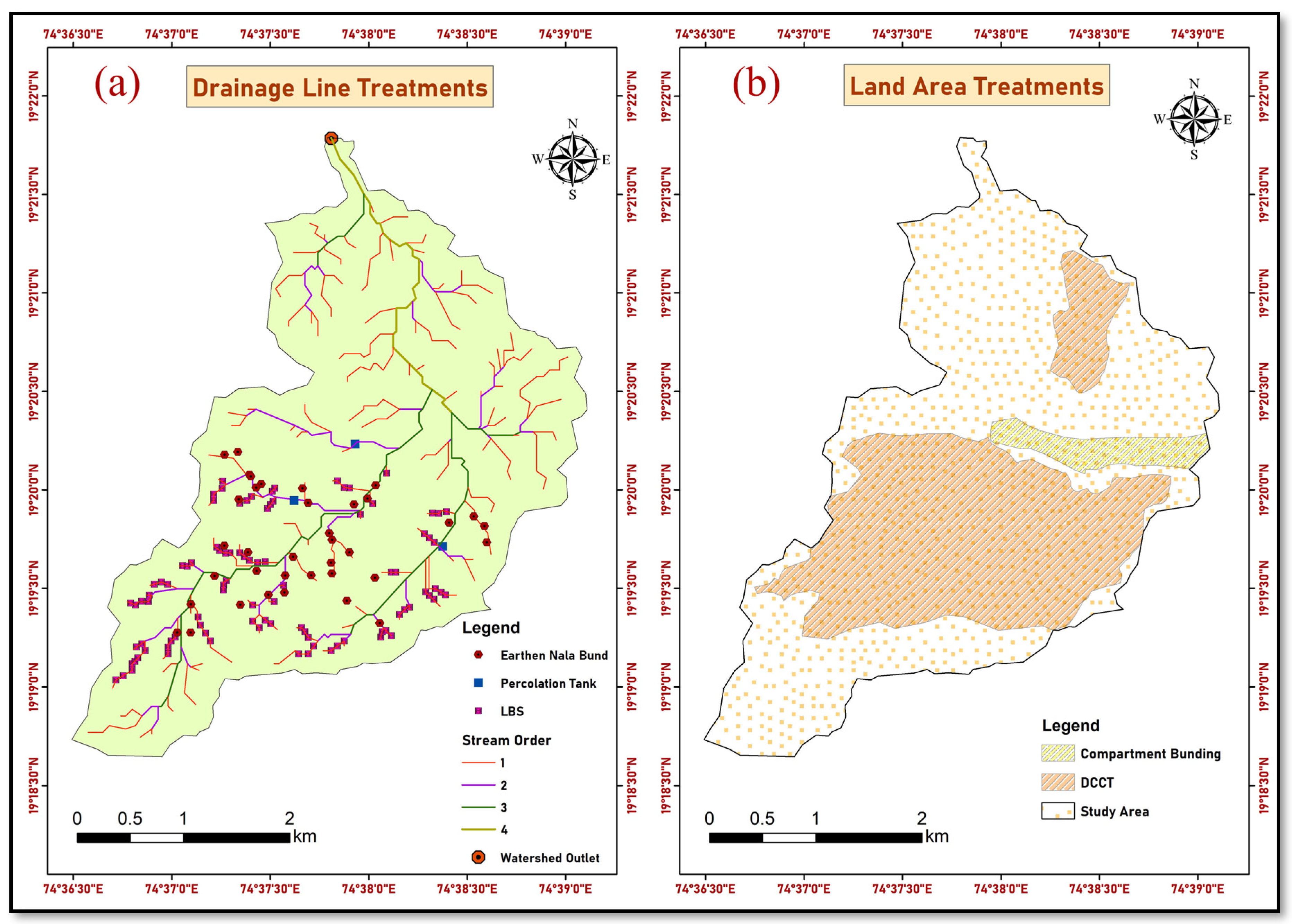
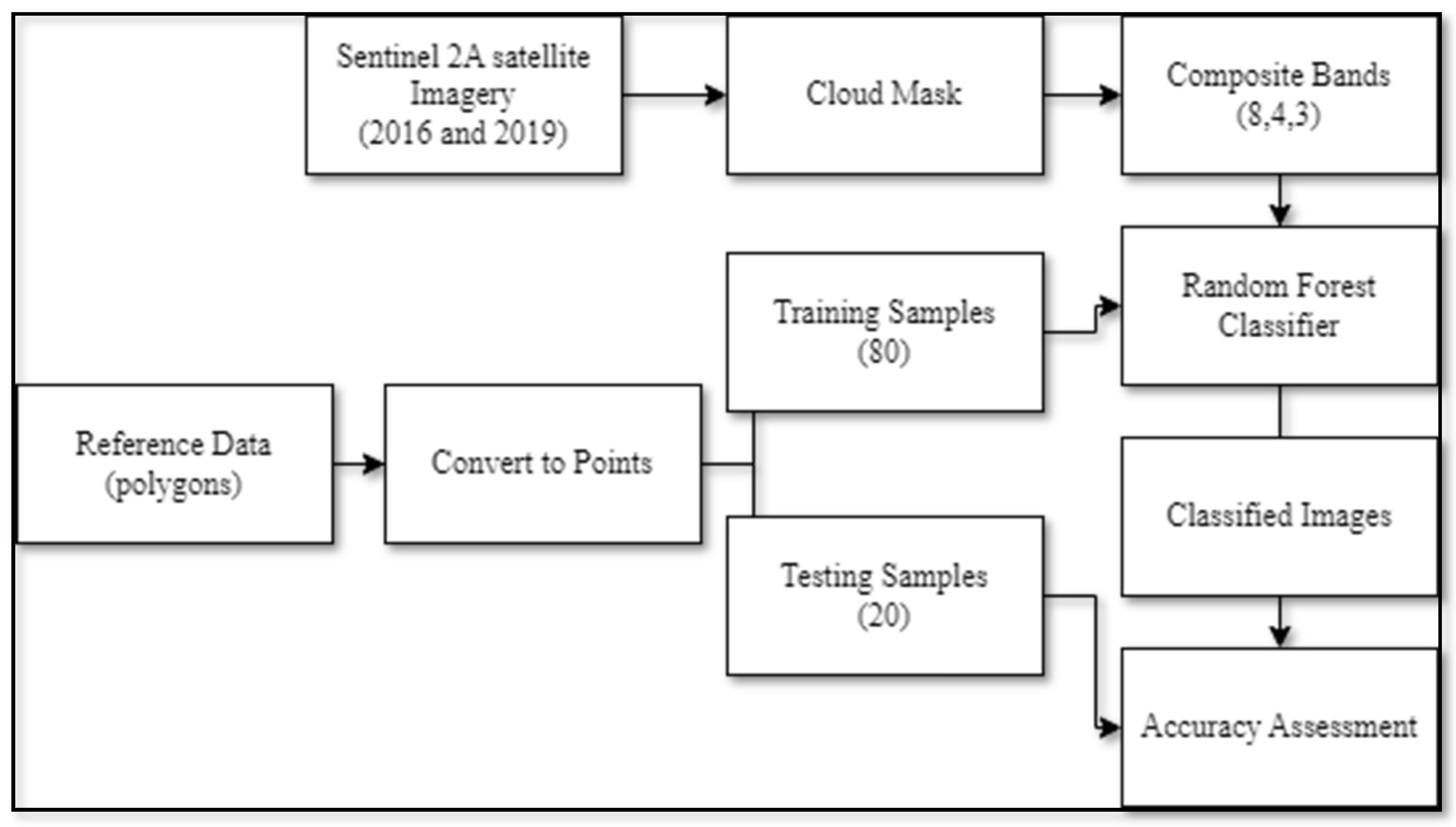

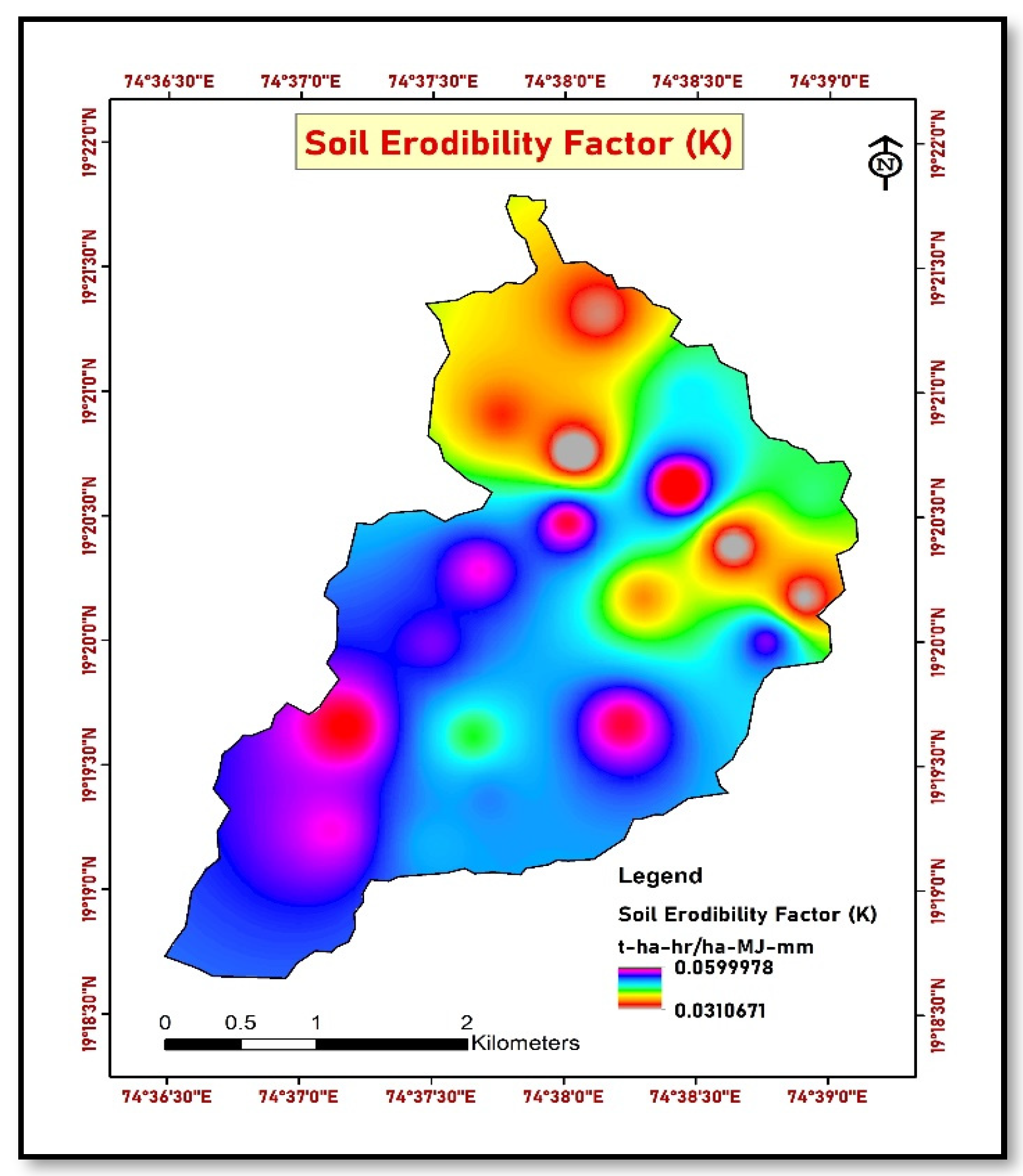
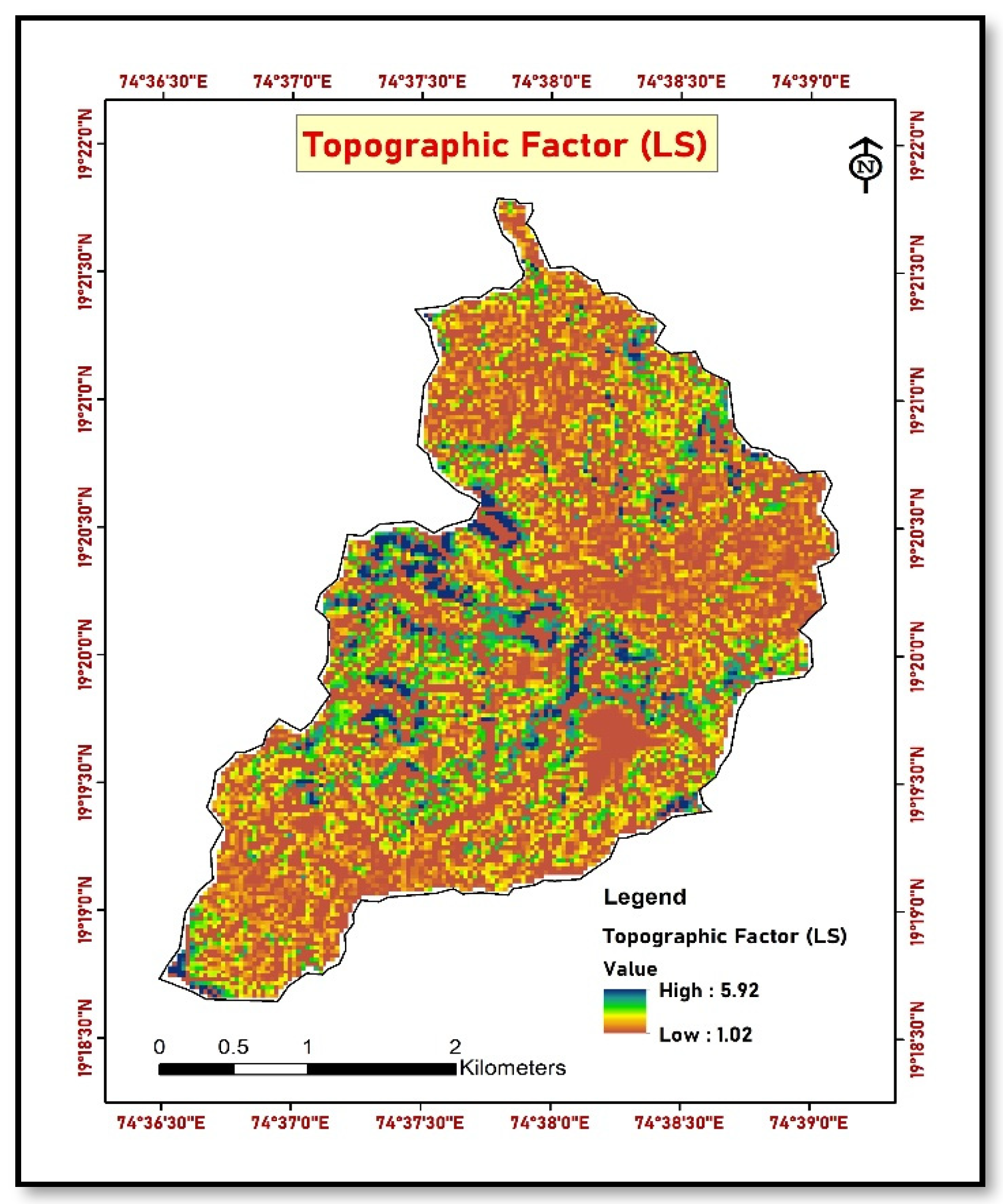

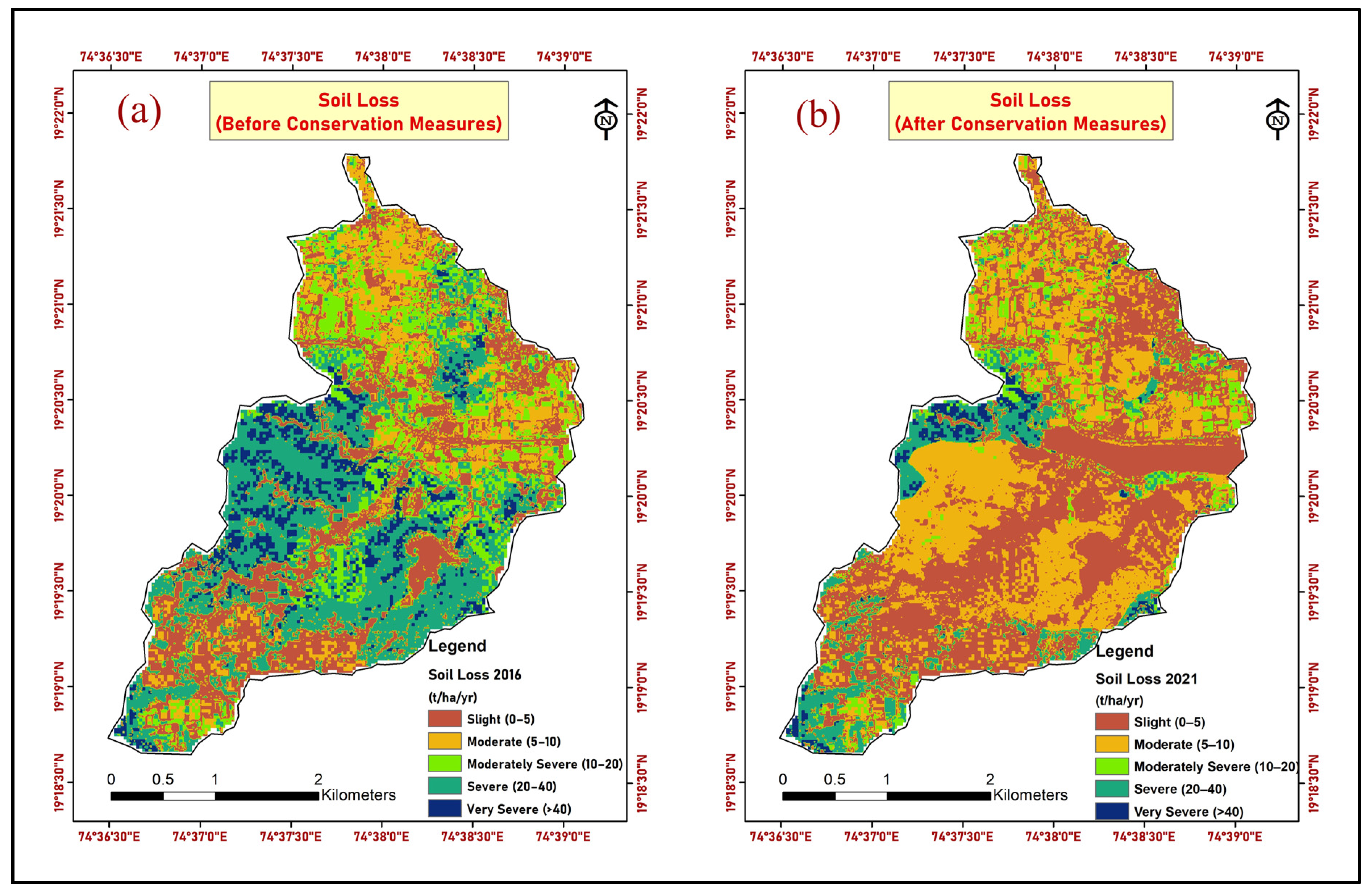

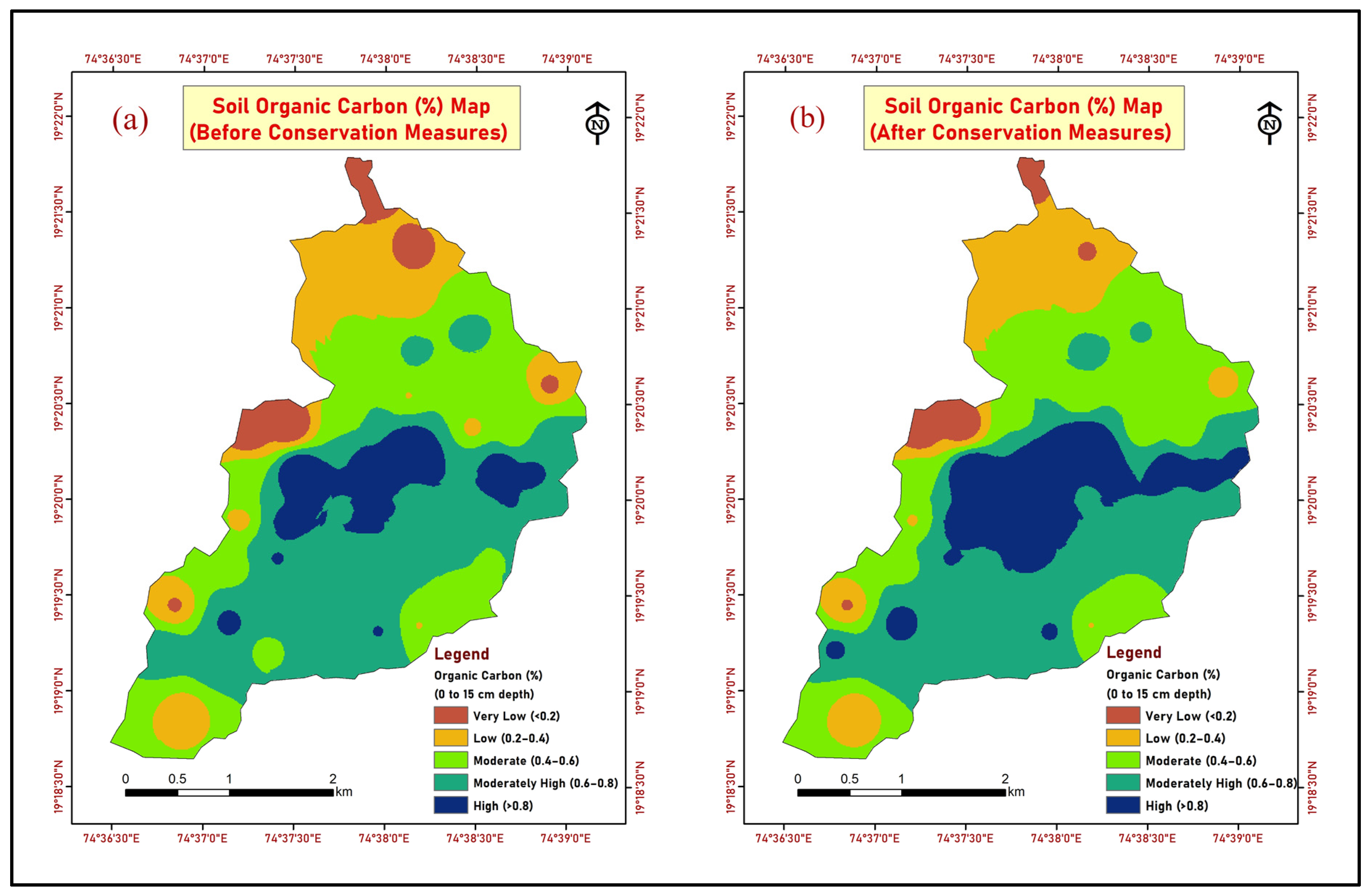

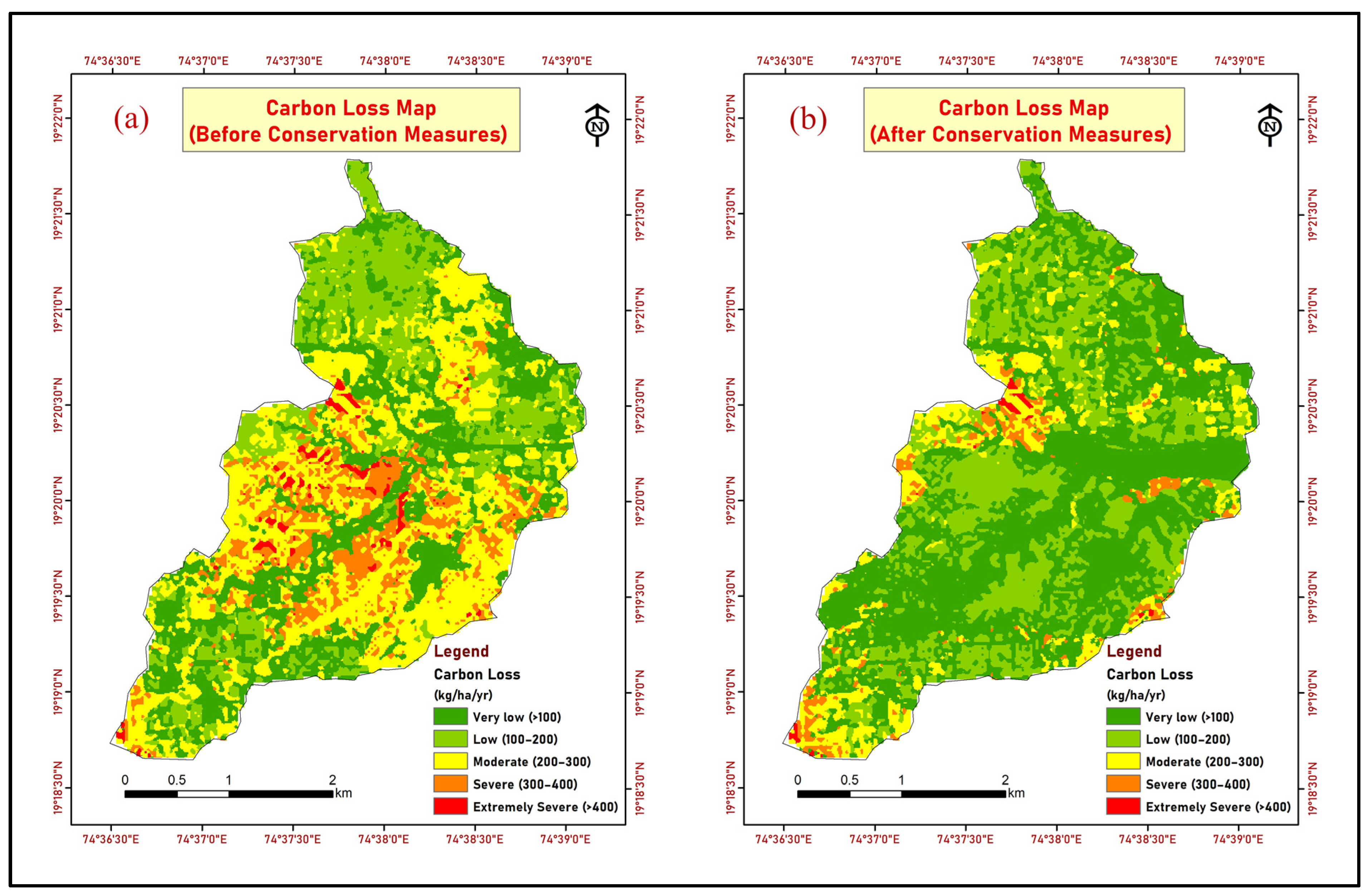
| Total Study Area | 1260 ha |
| Total Treated Area | 545 ha |
| Perimeter of treated area | 12.77 km |
| Area Under DCCT | 495 ha |
| Length of DCCT | 99,600 running m |
| Area Under Compartment Bunding | 50 ha |
| Earthen Nala Bunds | 38 nos. |
| Percolation Tanks | 2 nos. |
| Loose Boulder Structures | 97 nos. |
| USLE Parameters | Data Sources |
|---|---|
| Rainfall Erosivity Factor (R) | Rainfall data (1991 to 2021) collected from Department of Agrometeorology, MPKV, Rahuri. |
| Soil Erodibility Factor (K) | Field soil sampling and analysis (50 soil samples) |
| Slope Length Factor (LS) | Digital Elevation Model (SRTM Dem with 30 m spatial resolution) |
| Crop Management Fact (C) | Satellite Imagery (Sentinel 2A with 10 m spatial resolution) |
| Conservation Practice factor (P) | Field Survey |
| Sr. No. | Land Use/Land Cover | C Value |
|---|---|---|
| 1 | Forest [44] | 0.04 |
| 2 | Barren land [44] | 0.84 |
| 3 | Settlement [44] | 0 |
| 4 | Horticultural crops [45] | 0.1 |
| 5 | Agriculture land [45] | 0.45 |
| 6 | Waterbody [45] | 0 |
| 7 | Current fallow [45] | 0.6 |
| Sr. No. | Erosion Class | Erosion Range (t ha−1 yr−1) | CER Value |
|---|---|---|---|
| 1 | Very low | <5 | 3.62 |
| 2 | Low | 5 to 10 | 3.28 |
| 3 | Moderate | 10 to 20 | 2.3 |
| 4 | Severe | 20 to 40 | 2.3 |
| 5 | Extremely severe | >40 | 2.04 |
| Sr. No. | Land Cover Class | Year 2016 | Year 2021 | Change in Area (ha) | Change in Area (%) |
|---|---|---|---|---|---|
| (Before Conservation Measures) Area (ha) | (After Conservation Measures) Area (ha) | ||||
| 1 | Waterbody | 32.91 | 41.48 | 8.57 | 26.04 |
| 2 | Barren Land | 605.65 | 478.17 | −127.48 | −21.05 |
| 3 | Agriculture | 162.17 | 230.1 | 67.93 | 41.89 |
| 4 | Natural Vegetation | 231.95 | 304.97 | 73.02 | 31.48 |
| 5 | Current Fallow | 93.74 | 40.49 | −53.25 | −56.81 |
| 6 | Settlement | 58.39 | 72.82 | 14.43 | 24.71 |
| 7 | Horticulture | 75.19 | 91.97 | 16.78 | 22.32 |
| (−) ve value indicates decrease in area. | |||||
| Soil Type | Minimum | Maximum | Mean | Coefficient of Variation |
|---|---|---|---|---|
| Sandy Clay Loam | 0.031 | 0.052 | 0.044 | 15.64 |
| Sandy loam | 0.052 | 0.060 | 0.056 | 4.48 |
| Clay Loam | 0.029 | 0.033 | 0.031 | 6.08 |
| Soil Erosion Class | Soil Loss (t ha−1 yr−1) | Before Conservation Measures | After Conservation Measures |
|---|---|---|---|
| Area (ha) | Area (ha) | ||
| Slight | <5 | 365.27 | 574.75 |
| Moderate | 5 to 10 | 161.54 | 414.36 |
| Moderately Severe | 10 to 20 | 216.51 | 102.53 |
| Severe | 20 to 40 | 397.13 | 130.12 |
| Very Severe | >40 | 119.54 | 38.224 |
| Land Cover | SOC Content before Conservation Measures (%) | SOC Content after Conservation Measures (%) | Total Number of Samples |
|---|---|---|---|
| Agriculture land | 0.64 ± 0.07 | 0.76 ± 0.10 | 10 |
| Barren land | 0.51± 0.10 | 0.62 ± 0.11 | 15 |
| Natural Vegetation land | 0.70 ± 0.08 | 0.87 ± 0.07 | 15 |
| Horticulture land | 0.65 ± 0.04 | 0.81 ± 0.10 | 10 |
| Average | 0.62 | 0.77 |
| Carbon Loss Class | Carbon Loss Range (kgC ha−1 yr−1) | Before Conservation Measures | After Conservation Measures |
|---|---|---|---|
| Area (ha) | Area (ha) | ||
| Very low | <100 | 323 | 560 |
| Low | 100–200 | 250 | 415 |
| Moderate | 200–300 | 435 | 172 |
| Severe | 300–400 | 185 | 81 |
| Extremely Severe | >400 | 67 | 32 |
| Year | Parameter | Depth | Treatments | |||
|---|---|---|---|---|---|---|
| Agriculture # | Barren * | Forest * | Mango * | |||
| 2020 (Y1) | SOC (%) | 0–15 | 0.73 ± 0.08 | 0.61 ± 0.12 | 0.86 ± 0.6 | 0.78 ± 0.1 |
| 15–30 | 0.7 ± 0.04 | 0.57 ± 0.09 | 0.82 ± 0.06 | 0.75 ± 0.03 | ||
| Bulk density (gm/cc) | 0–15 | 1.38 | 1.46 | 1.46 | 1.43 | |
| 15–30 | 1.42 | 1.5 | 1.48 | 1.46 | ||
| SOC stock (t ha−1) | 0–15 | 15.111 | 13.359 | 18.834 | 16.731 | |
| 15–30 | 14.91 | 12.825 | 18.204 | 16.425 | ||
| 2021 (Y2) | SOC (%) | 0–15 | 0.76 ± 0.1 | 0.62 ± 0.11 | 0.87 ± 0.07 | 0.81 ± 0.1 |
| 15–30 | 0.72 ± 0.05 | 0.58 ± 0.06 | 0.83 ± 0.08 | 0.77 ± 0.05 | ||
| Bulk density (gm/cc) | 0–15 | 1.38 | 1.45 | 1.45 | 1.44 | |
| 15–30 | 1.43 | 1.49 | 1.47 | 1.47 | ||
| SOC stock (t ha−1) | 0–15 | 15.459 | 13.485 | 19.288 | 17.099 | |
| 15–30 | 15.114 | 12.923 | 18.451 | 16.626 | ||
| 2022 (Y3) | SOC (%) | 0–15 | 0.78 ± 0.09 | 0.64 ± 0.12 | 0.9 ± 0.1 | 0.85 ± 0.12 |
| 15–30 | 0.75 ± 0.08 | 0.59 ± 0.08 | 0.85 ± 0.1 | 0.78 ± 0.07 | ||
| Bulk density (gm/cc) | 0–15 | 1.39 | 1.46 | 1.46 | 1.44 | |
| 15–30 | 1.44 | 1.5 | 1.47 | 1.46 | ||
| SOC stock (t ha−1) | 0–15 | 15.901 | 13.633 | 19.791 | 17.491 | |
| 15–30 | 15.345 | 13.026 | 18.693 | 16.854 | ||
| Land Cover | 2020 (Y1) | 2021 (Y2) | 2022 (Y3) | SOC Increase Rate Y1 to Y2 | SOC Increase Rate Y2 to Y3 | Avg. SOC Increase Rate |
|---|---|---|---|---|---|---|
| Agriculture # | 30.021 | 30.573 | 31.246 | 0.552 | 0.673 | 0.612 |
| Barren * | 26.184 | 26.408 | 26.659 | 0.224 | 0.251 | 0.237 |
| Forest * | 37.038 | 37.739 | 38.484 | 0.701 | 0.745 | 0.723 |
| Mango * | 33.156 | 33.725 | 34.345 | 0.569 | 0.620 | 0.594 |
Disclaimer/Publisher’s Note: The statements, opinions and data contained in all publications are solely those of the individual author(s) and contributor(s) and not of MDPI and/or the editor(s). MDPI and/or the editor(s) disclaim responsibility for any injury to people or property resulting from any ideas, methods, instructions or products referred to in the content. |
© 2022 by the authors. Licensee MDPI, Basel, Switzerland. This article is an open access article distributed under the terms and conditions of the Creative Commons Attribution (CC BY) license (https://creativecommons.org/licenses/by/4.0/).
Share and Cite
Shelar, R.; Nandgude, S.; Tiwari, M.; Gorantiwar, S.; Atre, A. Impact Assessment of Soil and Water Conservation Measures on Carbon Sequestration: A Case Study for the Tropical Watershed Using Advanced Geospatial Techniques. Sustainability 2023, 15, 531. https://doi.org/10.3390/su15010531
Shelar R, Nandgude S, Tiwari M, Gorantiwar S, Atre A. Impact Assessment of Soil and Water Conservation Measures on Carbon Sequestration: A Case Study for the Tropical Watershed Using Advanced Geospatial Techniques. Sustainability. 2023; 15(1):531. https://doi.org/10.3390/su15010531
Chicago/Turabian StyleShelar, Rahul, Sachin Nandgude, Mukesh Tiwari, Sunil Gorantiwar, and Atul Atre. 2023. "Impact Assessment of Soil and Water Conservation Measures on Carbon Sequestration: A Case Study for the Tropical Watershed Using Advanced Geospatial Techniques" Sustainability 15, no. 1: 531. https://doi.org/10.3390/su15010531





